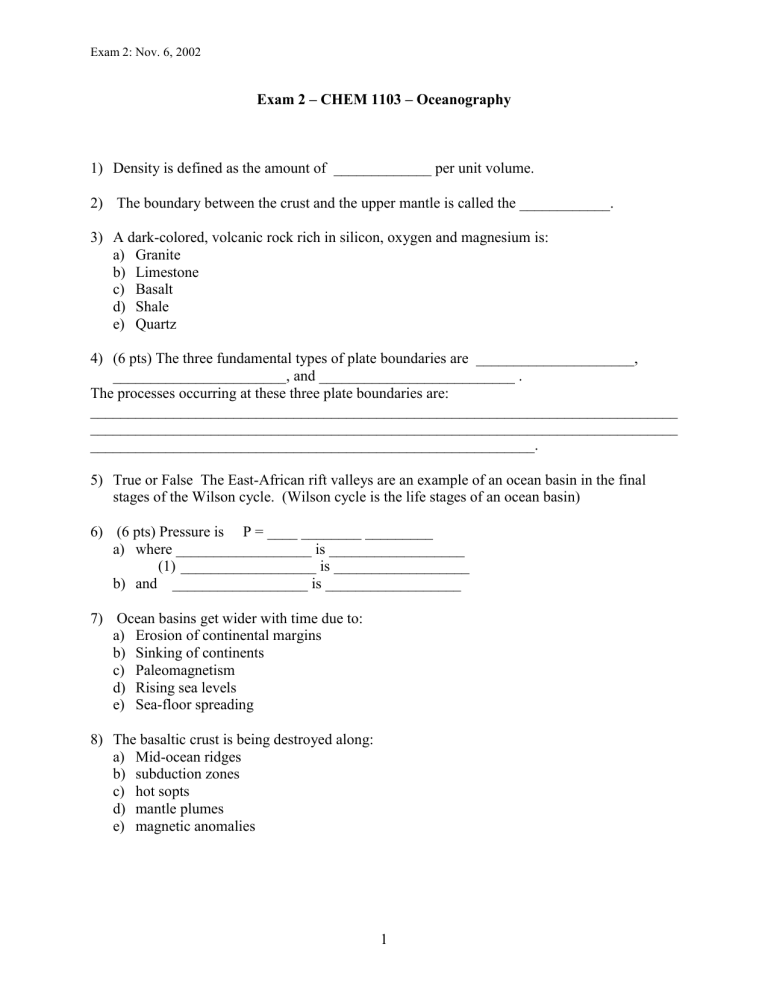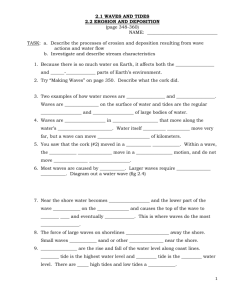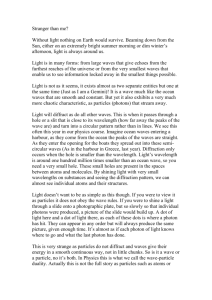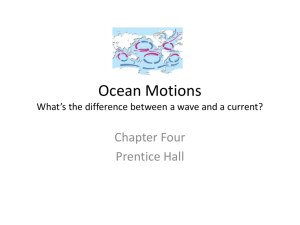practice exam

Exam 2: Nov. 6, 2002
Exam 2 – CHEM 1103 – Oceanography
1) Density is defined as the amount of _____________ per unit volume.
2) The boundary between the crust and the upper mantle is called the ____________.
3) A dark-colored, volcanic rock rich in silicon, oxygen and magnesium is: a) Granite b) Limestone c) Basalt d) Shale e) Quartz
4) (6 pts) The three fundamental types of plate boundaries are _____________________,
_______________________, and __________________________ .
The processes occurring at these three plate boundaries are:
______________________________________________________________________________
______________________________________________________________________________
___________________________________________________________.
5) True or False The East-African rift valleys are an example of an ocean basin in the final stages of the Wilson cycle. (Wilson cycle is the life stages of an ocean basin)
6) (6 pts) Pressure is P = ____ ________ _________ a) where __________________ is __________________
(1) __________________ is __________________ b) and __________________ is __________________
7) Ocean basins get wider with time due to: a) Erosion of continental margins b) Sinking of continents c) Paleomagnetism d) Rising sea levels e) Sea-floor spreading
8) The basaltic crust is being destroyed along: a) Mid-ocean ridges b) subduction zones c) hot sopts d) mantle plumes e) magnetic anomalies
1
Exam 2: Nov. 6, 2002
9)
True or False The Earth’s magnetic field is fixed and unchanging.
10) Tectonic plates are moved around by: a) Convection currents in the mantle b) Gravity c) Ocean currents d) Pressure gradients in the crust e) The heating and cooling cycles associated with the seasons
11) The Himalayan Mountain Range of Asia is an example of a _____________ plate. a) Divergent b) Convergent c) Transform
12) Ocean floor is neither created nor destroyed along ____________ plate boundaries. a) Divergent b) Convergent c) Transform
13) Island Chains are formed when a tectonic plate moves across a: a) Subduction zone b) Spreading center c) Volcano d) Mantle plume e) Earthquake zone
14) (5 points) Rank the following features in order according to their stage in the Wilson cycle a) Pacific Ocean b) Himalayan Mountains c) East African rift valleys d) Mediterranean Sea e) Red Sea i) 1 st _______________ ii) 2 nd _______________ iii) 3 rd _______________ iv) 4 tj _______________ v) 5 th _______________
15) Sediments formed at an earlier time, and which now appear out of place for the current depositional environment in an area, are termed ____________________.
16) Sediments originating from space are called __________________________.
17) Sediments created by organisms are called ___________________________.
2
Exam 2: Nov. 6, 2002
18) (4 pts) The two major types of sediments created by organisms are
__________________________ and __________________________.
The elements (nutrients) used for these two types of sediment are ________________ and
_________________.
19) The beds of sediment laid down by turbidity currents are called ______________.
20) Nodules rich in nickel and other minerals found on the deep sea floor are _____________ nodules.
21) Submarine canyons provide an important mechanism for: a) Bottom-dwelling organisms to move from the shelf to the slope b) Bottom-dwelling organisms to move from the slope to the shelf c) Nutrient-rich water to spill off the shelf onto the slope d) Sediment to be transported off the shelf
22) ___________ is rock composed of compressed mud.
23) ___________ is rock composed of compressed calcarious ooze.
24) The reddish color of the pelagic clays is due to the oxidation of minerals rich in: a) Iron b) Calcium c) Carbonates d) Manganese e) Magnesium
25) In the ________ model of tides, the Earth’s surface is considered to be completely covered by seawater to an infinite depth. a) equilibrium b) dynamic c) two-dimensional d) uniform
26) Tides are: a) shallow water waves b) capillary waves c) rogue waves d) deep water waves e) storm surges f) tsunamis
27) A seiche is a ______________ wave. a) standing
3
Exam 2: Nov. 6, 2002 b) progressive c) rogue
28) Only the __________ of a wave and not the mass of the wave is in motion a) energy b) orbit c) water
29) A deep water wave is one that is moving through water that is deeper than: a) 200 m b) three times its height c)
½ its wavelength d) 3000 m e) 11,022 m
30) The horizontal distance between successive crests is the: a) wavelength b) wave height c) wave crest d) wave trough e) wave period
31) A wave will break when the height has increased to about _____________ of the wavelength
(Stoke’s criteria). a) 1./13 b) 2/3 c) 5/8 d) 1/7
32) Wave height divided by wavelength will give the wave: a) dispersion b) speed c) period d) steepness e) node
33) Waves which slosh back and forth in harbors and have very long periods are called: a) capillary waves b) chop c) tsunamis d) seiches e) surge
34) The crest of a tide is called ____________________ tide.
4
Exam 2: Nov. 6, 2002
35) Wave height is defined as the vertical distance separating the _________ from the
_________.
36) A substantial rise in sea level along a coast during a severe storm is called a storm a) tide b) surge c) surf d) swell e) tsunami
37) Water particles in waves move: a) only up and down b) only back and forth c) in circular orbits
38) The distance over which the wind blows to create waves is termed: a) fetch b) distortion c) convection d) defraction e) refraction
39) (True or False) The flood tide occurs as water flows out after high tide.
40) (True or False) Standing waves do not move.
41) The tidal bulge on the side of the Earth opposite the moon is due to: a) centrifugal force b) tidal bore activity c) ebb currents d) tidal resonance e) spring tides
42) When the crest of one waves coincides with the trough of another wave, ___________ interference occurs. a) destructive b) constructive c) confused d) cumulative
43) The greatest expanse of beach is flooded at high tide during: a) neap tides b) spring tides c) semidiurnal tides d) diurnal tides
5







